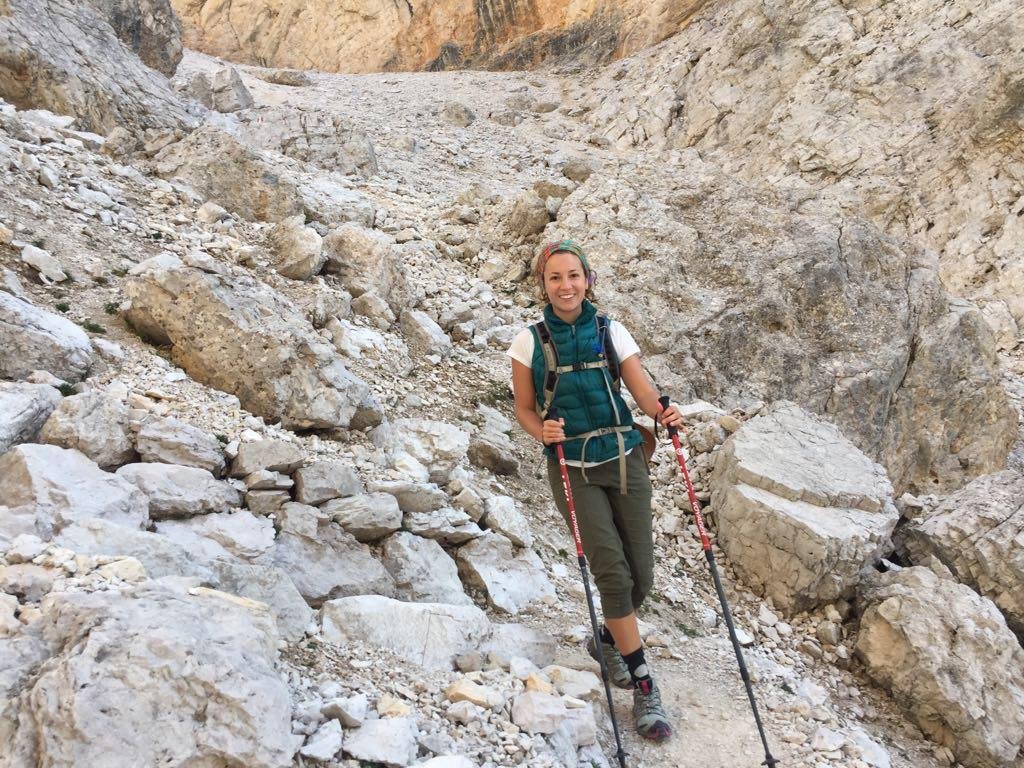Packing for a multi-day trek can be daunting, but this guide is here to help you pack everything you need without overpacking. This essential packing list for a multi-day trek is built off of the philosophy of less is more and in this case, when everything you are bringing is going on your back for 8-10 hours a day, you will most definitely be happy you packed less.
1. Ultra-light backpack
Bring a pack with you that is designed for backpacking trips. Instead of a one-size fits all pack, you’ll want to be fitted for one that aligns with your body measurements. The weight of your pack needs to sit on your hips, so you’ll need to measure yourself and understand what size pack your body requires.
The goal is to find a pack with all the bells and whistles without the extra weight. Things I like to look for in a trekking pack:
- Bottom zipper for easy access to my entire pack
- Mesh pocket on the front to store extra layers
- Mesh liner on the backside of the pack to increase airflow for sweaty back moments
- Various adjustment straps, not only to fit to my body, but also to help distribute the weight of the pack. (Think adjustment straps on the shoulder straps to bring the top of the pack closer to your upper body.)
- ‘Brain” to store less bulky items.
I have been using this Osprey pack for the last five years now, check it out:
2. Hiking Shoes / Boots
Despite the terrain you will be hiking, you will want to ensure your hiking boots are waterproof. You will most definitely encounter some sort of scenario where you will want the peace of mind of waterproof hiking shoes or boots. Think muddy trails, river crossings and just good old rainfall.
Another thing to consider is the terrain itself, are you going to be hiking on rocky and uneven terrain? If so, pick a pair of hiking shoes that have strong soles, you don’t want to start feeling each rock under your foot on day two, lets keep that for day four or five.
For me, the next tip of advice for hiking boots comes down to personal preference, disregarding all the information out there advising towards ankle support hiking boots. If the terrain is extremely uneven or if you’ll be encountering snow, you’ll want to consider boots with ankle support. If that isn’t your thing, you can always use gaiters for your snowy trails.

3. Hiking poles
Leave the judgement at home when it comes to these babies and pick up those poles.
Since hiking poles have the tendency to evoke a little bit of controversy in the hiking world, let me give you some pros and cons on the use of hiking poles for your next thru-hike.
Pros:
- Shock Absorbers: The biggest benefit of using trekking poles is that they absorb shock so that your knees don’t have to, and therefore take stress off your joints. I have a hard time with knee pain while descending and hiking poles help relieve a lot of pain here.
- Increased Stability: Hiking poles provide you with four points of contact to the ground, therefore you’ll have much better balance and increased stability by using them. This new sense of increased stability is best used on uneven terrain, steep ascents or descents, water crossings and treks over loose rocks, wet trails, and snow.
- Keep a consistent pace and your arms have a job too.
Cons:
- Weight. This can be a con in a couple of ways. One, if you’re trekking poles themselves are made from a material that is too heavy (Look for poles that are made out of carbon fiber or aluminum). Second, if you decide to stash your poles in your pack during traverses this equals extra weight on your back throughout your trip.
- You will expend additional effort on your hike since you’ll be moving your arms, too.
- Sometimes Annoying: Hiking poles can become cumbersome either with the additional effort required to adjust the poles depending on whether you are ascending or descending. (When you are ascending its best to have the poles a bit shorter to assist with momentum, while descending on the other hand, you’ll want to adjust your poles to be longer so that you can slow down your momentum.) Another scenario is when you are on a portion on a trail where rock scrambling is required.
Overall, there is a time and a place for hiking poles. And I would say that a thru-hike in the mountains is that time and place.
4. Layers
Depending on where you are completing your thru-hike, you’ll hear the expression that you’ll experience all seasons in one day or the weather changes every five minutes. This means a sunhat and a wool cap are on your essential packing list for a multi-day trek.
When we did our multi-day trek in Norway, we experienced three seasons in one day, but if we had completed it a few weeks earlier, it would have been four seasons. The lesson here is to be prepared, and the best way to be prepared for three or four seasons in one day is to be bring layers. When choosing layers, I like to prioritize an item’s versatility and material. For instance, I focus on packing quick-drying and merino wool items, especially tops.
Your pits will thank you.
5. Raingear
Raingear for all day hiking means a raincoat, rain pants and a rain cover for your pack. Look for Gortex pants with a mesh-lining on the inside, this will help keep the moisture out when you start to sweat. Another tip would be to look for a pair that packs well since ideally you won’t be wearing these all day, every day on your multi-day trek.
6. Water-friendly sandals
For me, a second pair of shoes is a must on a multi-day hike. There is nothing worse than take off your hiking shoes to have to put them back on once you are done with hiking for the day. Give your feet a break and bring a pair of sandals, preferably a pair you can wear with socks (#shoebelife). The key is to bring water-friendly sandals since if you are staying in mountain huts or Refugio’s you will be taking using a communally based shower. Do I need to say more…sandals are the way to go here. Another thing to note is that most mountain huts, if not all, do not allow hiking shoes inside so you will either walk barefoot or with sandals designated for indoors.
7. Micro-fiber towel
You’ll need to bring a travel size micro-fiber towel for showers and for any spontaneous dips in the alpine lakes. These are quick drying and packable towels. Some huts will rent you towels but its always better to have your own.
8. Toiletries
Pack only the bare minimum, and for the wise, that means leave the deodorant at home. Mostly, you just need body wash, toothpaste, and a toothbrush. I also decided to bring face moisturizer with SPF, lip balm, conditioner, and a hairbrush.
9. Sunscreen
There is nothing worse than sunburn or unwanted tan lines. Sunscreen can help you avoid this. You’ll be at a higher elevation and closer to the sun.
Don’t let the breeze fool you, you can still get burnt even if you’re chilly. Sunscreen not optional on your essential packing list for a multi-day trek.
10. Sunglasses
Protect your eyes. What more do I need to say?
11. Buffs
A buff or a bandana can be lifesaver in more than one scenario. Think about being surrounded by flies or little gnats for hours and by accident breathing them in…buff to cover your mouth. It is getting windy…buff! You’re cold…buff! The back of your neck is getting sunburn…buff!
12. Silk Sleep Sac
Mountain huts and Refugio’s do not wash their bedding regularly and by regularly I do not mean they forget to wash the sheets for a week or two, I am talking for the season. Maybe they only wash the sheets yearly. Not only is it required for you to use a sleep sac, but you also want to. The best sleep sacs I have used have been made from silk. They help keep you cool and its so soft on your skin.
13. Eye mask & ear plugs
I will never go on a multi-day trek while staying at mountain huts without an eye mask or ear plugs. When your accommodation is dormitory style, you are at the mercy of other people. This means when they go to bed, when they wake up, if they turn the light on or use a flashlight while doing either or both. The noise of the beds creaking, the door opening and closing or other’s getting ready or moving about can at least be muffled by ear plugs. The risk of being woken up increases with the volume of people sleeping in your dorm room. My advice is to be prepared.
In conclusion, packing for a multi-day trek requires careful consideration and planning to ensure that you have everything you need without overpacking. By following the essential packing list for a multi-day trek above and packing light, you’ll be able to enjoy your trek through Europe comfortably and with ease. Remember, when it comes to packing for a multi-day trek, less is more.
